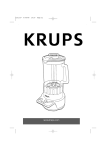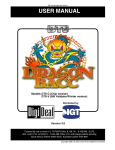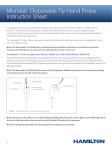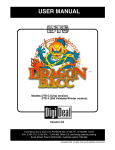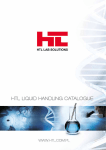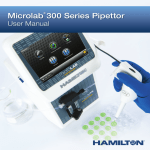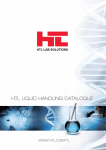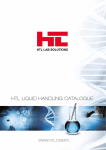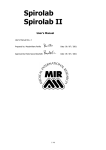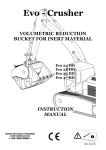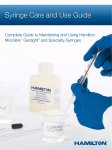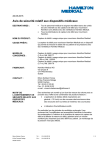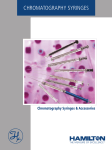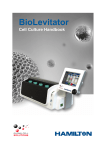Download SoftGrip Multi-Channel - English
Transcript
SoftGrip™ Multi-Channel Pipettes User Manual New Pipette Picture to Come 1 of 12, 2063-01 (Rev. E) Welcome Thank you for choosing a SoftGrip pipette from the Hamilton Company. TM Before using your new pipette, please review the important information in this manual on pipette features, basic operation, calibration, optimizing performance, maintenance, and troubleshooting. For French, German, and Spanish translations of this manual, please visit www.hamiltonpipettes.com. For sales and support in countries outside the U.S., please contact your local dealer. For additional information in the U.S., call Hamilton Sales and Support at 1-888-525-2123 and visit our website at www.hamiltonpipettes.com. www.hamiltonpipettes.com Sales/Support USA 1-888-525-2123 Pipette Warranty Hamilton Company unconditionally guarantees its products to be free of defects in materials and workmanship for one year from date of delivery. Any product that fails due to such defects will be repaired or replaced at our discretion without cost, provided the device is returned with an explanation. It is the responsibility of the purchaser to determine the suitability of application and material compatibility of the products based on the published specifications of the products. The specified accuracy and precision performance of Hamilton pipettes is guaranteed only when used with Hamilton Precision Pipette Tips. SoftGrip pipettes are protected by U.S. Patent Number 5,983,733 with other patents pending. of 12 888-525-2123 2063-01 (Rev. E) Hamilton SoftGrip™ Pipettes Hamilton Company is the leader in precision fluid measurement products. We extended our world-renowned syringe expertise to the SoftGrip Manual Pipettes specifically designed to deliver maximum accuracy and minimize hand injuries. The results set the standard for precision, comfort, and value. SoftGrip multi-channel pipettes are continuously adjustable volume pipettes and available as 8- or 12-channel models for pipetting into 96-well plates. The pipettes feature a soft, nonslip handle for a relaxed grip; lighter plunger action for more comfort; and a separate tip ejector to reduce hand motion. The curved hilt supports the pipette for finer control while pipetting. The easily activated tip ejector lever releases all tips with a single stroke. The ejector lever rotates to a comfortable setting for left- or right- handed use with a simple turn of the lower body adjustment ring and tip ejector. Each channel has a separate piston and seal. The hardened, stainless steel pistons are precision ground and polished to ensure accurate performance, and provide exceptional piston and seal life. SoftGrip pipettes operate on the air displacement principle and use disposable tips. Every pipette is calibrated at the factory with standards traceable to N.I.S.T. and shipped with a Certificate of Calibration documenting the pipette’s accuracy and precision. Sloped Plunger (Color Coded) Soft Nonslip Handle Curved Hilt Volume Display (Color Coded) Volume Adjustment Ring Tip Ejector Lever Lower Body Adjustment Ring Diposable Pipette Tips 2063-01 (Rev. E) www.hamiltonpipettes.com of 12 Volume Setting The isolated volume adjustment ring prevents accidental volume changes. To set the volume, hold the pipette vertical with the volume display in front of you and turn the volume adjustment ring to the desired volume. Set the desired volume to within the pipette’s volume range as given below. For the greatest attainable accuracy, always turn the adjustment ring down to the desired volume. If you are starting at a setting lower than the one desired, turn the adjustment ring past that volume and then turn back to the desired volume. When setting volumes, start your settings from the top digit on the volume setting display. Full units are expressed in black digits. Incremental units, the values to right of the decimal point, are expressed in red digits and appear below the full units. The graduated scale identifies the least significant digit. Notes: For the 50 µL pipettes, the red digits on the scale reading are to the right of the decimal point. For the 300 µL pipettes, only the last digit, obtained from the graduated scale, is to the right of the decimal point. For the best accuracy and precision, use your pipette only within the recommended volume range of 10-100% of the specific pipette’s total volume range. Recommended Volume Ranges Pipette Volume 50 µL 300 µL Sandstone Brick Red Recommended Volume Range 5-50 µL 30-300 µL 100% Volume Setting 50.00 µL 300.0 µL 5 0 0 3 0 0 5.00 µL 30.0 µL 0 5 0 0 3 0 0.02 µL 0.2 µL Pipette Color Reading at 100% Volume 10% Volume Setting Reading at 10% Setting Smallest Increment of the Scale of 12 888-525-2123 2063-01 (Rev. E) Pipette Operation 1.Press disposable tips firmly onto the pipette’s lower body assembly. To assure an airtight seal, gently rock the handle from side to side before lifting the tips from the rack. 2.Depress the plunger button to the first stop. Hold the pipette vertically and immerse the tips 2 to 4 mm into the sample below the meniscus. 3.Slowly release the plunger button to aspirate sample. 4.Withdraw the tips from the sample, touching-off on the side of the container. 5.To dispense, place the tips against the inside wall of the receiving vessel and depress the plunger button to the first stop. Pause and then depress the plunger button to the second or blowout stop. Hold the plunger button down, sliding the tips out along the inside of the receiving vessel. 6.Release the plunger button. With the disposable tips directed into a safe receptacle, depress the tip ejector to dispose of the tips. Adjusting for Left-Handed Operation The pipette is delivered ready for right-handed operation. Both the tip ejector and lower body can be easily rotated for left-handed operation. 1.The tip ejector lever can be rotated a full 360º relative to the handle by gently pushing the lever away from the handle. While the handle assembly is lifted, rotate the lever to the desired position and then release the lever. 2.The entire lower body assembly can be rotated a full 360º relative to the handle by loosening the lower body adjustment ring. Rotate the lower body to the desired position and retighten the lower body adjustment ring. Pre-Rinsing Tips Pre-rinsing pipette tips is recommended for all pipetting operations. To pre-rinse, aspirate and dispense the sample one to three cycles. On the last rinse, press the plunger past the blowout stop to clear the tips of any sample. Make sure there are no micro-droplets in the tips before aspirating the first sample. If micro-droplets remain in any tips, replace the tips and pre-rinse. Pipette Calibration Hamilton SoftGrip pipettes can be gravimetrically calibrated by the user. A universal calibration key is available so that the pipette can be adjusted to accommodate specific fluid viscosities and environmental factors such as temperature, humidity, altitude, etc. Use a 5- or 6-place balance depending on the volume being measured. A 5-place balance should be accurate to within ±0.01 mg and a 6-place balance should be accurate to within a ±0.001 mg. All items used to perform the calibration must be allowed to equilibrate to room temperature (20-25 ºC, constant to ±0.5 ºC). Each time you recalibrate the pipette, initial and date a new calibration label and replace the current label. Also, in accordance with your organization’s instrument operation practices and standards, we recommend following 2063-01 (Rev.E) www.hamiltonpipettes.com of 12 good laboratory practices by calibrating your pipette on a regular basis, i.e., three month intervals, using the following procedure, or a known standard method, such as DIN 12650. Depending on the frequency of use and the liquids measured, other time intervals may be more appropriate. To Calibrate 1.Attach a disposable tip to a chosen channel (a middle channel is recommend) and pre-rinse the tip. 2.Set the desired or the lowest volume at which the pipette will be used. 3.Make 10 measurements of distilled water per tip, recording the weights. Adjust for environmental factors, e.g., temperature, humidity, and altitude. 4.Calculate the mean and standard deviation. 5.If necessary, adjust the volume. However, adjust the volume only after confirming the error is not due to other causes. Refer to the sections on Optimizing Performance and Troubleshooting. Adjusting the volume will affect all channels. a.Remove the calibration label and locate the calibration reference mark. b.Remove the plunger cap by pulling the plunger button off the pipette. c.Inset the calibration key, turning the calibration key clockwise to increase volume and counter-clockwise to decrease volume. Each vertical line on the calibration key is approximately 0.2% of the pipette volume. d.Remove the calibration key and replace the plunger cap. Repeat the gravimetric procedure until results are satisfactory. 6.Initial and date a new calibration label, placing the label on the pipette hilt. The pipette can be recalibrated for liquids with a density other than water. Follow the calibration procedure above with the pipette set at the required volume. Use the liquid to be sampled. With this type of calibration adjustment, the pipette is calibrated only for the liquid used and the volume tested. The pipette should be labeled as such, and should not be used for other sampling applications unless it is recalibrated. Calibration Label and Key Calibration Label Calibration Reference Mark Plunger Cap Calibration Key Showing Vertical lines Test Conditions Liquid Deionized, degassed, distilled water Reference Temperature 20-25 ºC, constant to ±0.5 ºC Number of Measurements 10 per channel per volume setting, referencing ASTM 1154 Guidelines Pipette Tips Hamilton pipette tips of 12 888-525-2123 2063-01 (Rev.E) Performance Specifications Volume Range Part No. Color Coding At 10% of At 100% of Pipette Volume Pipette Volume Accuracy Precision Accuracy Precision within within within within ±% +% ±% +% 55019-50 5-50 µL x 8 Sandstone 2.00 2.00 0.80 0.35 55019-52 30-300 µL x 8 Brick Red 1.20 0.70 0.50 0.30 55019-54 5-50 µL x 12 Sandstone 5.00 2.00 1.00 0.50 55019-56 30-300 µL x 12 Brick Red 2.40 0.70 1.00 0.50 Optimizing Performance Topic Action Consistent Technique Pipette with a consistent rhythm, pressure, and speed Tip Selection Use Hamilton pipette tips for guaranteed accuracy. For information, visit www.hamiltonpipettes.com Tip Size and Fit Use proper size tip, firmly placed on pipette shaft Pre-Rinse Tips Pre-rinse pipette tips for improved precision Sample Aspiration Keep the disposable tips immersed in fluid during aspiration. Do not let the plunger snap back to starting position. Immersion Depth Maintain an immersion depth of 2 to 4 mm Immersion Angle Maintain an angle of <20º from vertical Viscous Samples Aspirate slowly. If bubbles are observed, resample. Volume errors may still occur. Refer to the Calibration section. Acid Samples Pipetting strong acids and corrosive solutions is not recommended. These liquids may damage the pistons and seals. To protect the pipette, use filter barrier pipette tips and inspect piston frequently. For more information, visit www.hamiltonpipettes.com High Vapor Pressure Samples Pipetting solutions with high vapor pressure is not recommended. These liquids may damage the pistons and seals. Sample Temperature Fluids at a temperature other than that for which the pipette and pipette tips have been calibrated may result in volume measurement errors. Storage Store upright in stand. Do not lay the pipette on its side with fluid in the tips. Fluid reaching the pistons causes contamination and possible corrosion. Cleaning Piston Wipe piston with alcohol and a soft, lint-free cloth. Dry and lightly lubricate the piston (Lubricant, Part No. 5763-01). Seal Replacement Replace the PTFE seals every 3-6 months depending on use and the samples aspirated Performance Checks Check the accuracy and precision of your pipette every 3-6 months depending on use and the samples aspirated 2063-01 (Rev. E) www.hamiltonpipettes.com of 12 Troubleshooting Problem Possible Cause Recommended Remedy Inaccurate Results Pipette tip not attached correctly Check for tip fit and check for proper tip size, replacing tip as needed Aspiration stoke too rapid (viscous fluids) Aspirate slowly by controlling rate of plunger release Calibration required Calibrate the pipette Seal leak (dripping fluid) Replace the seal Inconsistent sampling method See section on Optimizing Performance Seal leak Replace the seal Imprecise Results Cleaning Wipe the outer surface of the pipette with a mild soap and water daily. In case of accidental contamination of the piston chamber shaft, immediately disassemble the piston chamber. Refer to the Replacement Parts section for instructions. In addition, rinse the ejector plate and piston assembly with mild soap and water followed by distilled water. Dry all components completely. Lightly lubricate the pistons (Lubricant, Part No. 5763-01). Autoclaving The entire pipette is autoclavable at 121 ºC for 15 minutes at 15 psi (103.5 kPa or 1.02 atm) pressure without the need for any disassembly. Although autoclaving should not affect pipette accuracy, practice good laboratory procedures by checking your pipette and recalibrating as needed. Pipette Parts Diagrams 5. Ejector Plate 2. Cover 1. Plunger Cap 4. Piston Chamber Assembly 3. Spring Clip Header (not replaceable) Replacement Parts Table Part Description 1. Plunger Cap 8 x 50 µL 12 x 50 µL 8 x 300 µL 12 x 300 µL 54190-06 54190-06 54190-10 54190-10 2. Cover 4917-014916-014917-014916-01 3. Spring Clip 34354 34354 34354 34354 4. Piston Chamber Assembly 6385-01 6385-01 6385-02 6385-02 5. Ejector Plate 4923-014922-014923-014922-01 of 12 888-525-2123 2063-01 (Rev. E) Replacement Parts Hamilton pipettes have been uniquely designed so simple repairs and part replacements can be performed by the user. The Replacement Parts Table lists all pipette replacement parts identified by Hamilton part numbers. To replace parts refer to the Pipette Parts Diagram. 1.Snap the front and back covers off of the pipette. If necessary, insert a flathead screwdriver into slot on the side of the lower body and rotate gently. 2.Unhook the two spring clips securing the ejector plate. 3.Remove the ejector plate. 4.Using a Phillips head screwdriver, remove the screw that secures the piston chamber assembly and gently remove piston chamber assembly. 5.Lightly lubricate entire circumference of pistons using a soft, lint-free cloth (Lubricant Part No. 5763-01). 6.Insert and slide the pistons into the new piston chamber assembly. Make sure that the seal flanges are oriented towards the plunger with the O-rings below the flanges towards the tip. 7.Adjust the position of the piston chamber assembly so that the screw on the back goes into the large end of the opening on the opposite side. With the screw side facing you, slide the piston chamber down so the screw goes to the very bottom of the opening, and tighten the screw. 8.Reinstall the ejector plate, with the longer lip facing the front (the side without the screws), and secure the ejector plate with the spring clips. 9.Snap the front and back covers back together. To assure that your instrument meets the original Hamilton Company standards and specifications, we strongly suggest that you follow Good Laboratory Practices by recalibrating your pipette after replacing any parts. Pipette Recertification and Repairs Recertification Hamilton Company offers a program to recertify the accuracy and precision of your Hamilton pipette. Testing is performed at a Hamilton facility under stringent conditions on state-of-the-art equipment. The calibration process is performed with an unbroken chain of calibrations traceable to N.I.S.T. Your pipette will be returned to you with a new Certificate of Performance. If a pipette must be repaired to bring it into conformance, you will be contacted with a cost estimate. Repairs Hamilton Company offers a pipette repair program in addition to its general, 12-month warranty. You may return your Hamilton pipette for evaluation. A series of basic tests will be performed to evaluate the pipette’s performance. If repairs are required to assure and confirm that your pipette is functioning to original Hamilton specifications, you will be contacted with a cost estimate and the additional repairs and recalibration will be performed upon your approval. Your pipette will be returned to you with a new Certificate of Performance. For pipette recertification and repairs in the U.S.A., call 1-888-525-2123. For authorized service outside of the U.S.A., contact your local Hamilton Company office or representative using the contact information on the back cover. 2063-01 (Rev. E) www.hamiltonpipettes.com of 12 Return of Goods Hamilton return and repair policy is written to protect our employees from potentially hazardous materials (e.g., infectious agents, radioactive materials, and carcinogenic chemicals) or any substance that may cause them partial or permanent disability during the inspection or repair process. When returning products, please ensure the items are decontaminated and marked accordingly. Furthermore, the customer assumes responsibility should the returned product be determined to be hazardous. All returns must be accompanied by a pre-approved Returned Goods Authorization Number (RGA#). Any return not received without a RGA# may be disposed. Contact Hamilton Customer Service at 1-888-525-2123 for an RGA#. Hamilton Precision Pipette Tips Hamilton delivers performance, value, and choice with two high quality tip families, plus multiple formats and packaging options. The tip families are low retention/low binding tips for maximum sample recovery and standard tips for routine, high-throughput work. Formats include standard, non-filter, extended length, hydrophobic filter barrier, non-sterile, pre-sterilized, and macrovolume. Packaging options include bulk bags, hinged and lift-off racks, and stackable racks. Hamilton tips are made from chemically resistant, virgin polypropylene for excellent clarity and smooth surfaces. All Hamilton pipette tips are certified to be free of RNase, DNase, and pyrogens. Hamilton pipette tips are universal-fit. For more information, visit www.hamiltonpipettes.com 10 of 12 888-525-2123 2063-01 (Rev. E) 2063-01 (Rev. E) www.hamiltonpipettes.com 11 of 12 www.hamiltonpipettes.com Sales/Support USA 1-888-525-2123 Hamilton Company 4970 Energy Way Reno, Nevada 89502 USA Toll-Free: 800-648-5950 Telephone: +1-775-858-3000 Fax: +1-775-856-7259 Email: [email protected] Hamilton Bonaduz AG Via Crusch 8 CH-7402 Bonaduz/Switzerland Toll Free: 00800-660-660-60 Tel. +41-(0)81-660-60-60 Fax: +41-(0)81-660-60-70 Email: [email protected] Quality Hamilton Products– MICROLITER™ Syringes GASTIGHT® Syringes Chromatography Syringes Syringes for Life Science Instrument Syringes SoftGrip™ Pipettes Miniature Valves Modular Valve Positioner Laboratory Fittings, Adapters & Tubing Precision Syringe Pumps MICROLAB® Diluters & Dispensers Electrochemical Sensors DURACAL™ Buffer Solutions HPLC Columns & Resins Laboratory Automation for– Drug Discovery Genomics Proteomics Forensics In Vitro Diagnostics TRADEMARKS: The following are trademarks of Hamilton Company AdvanTip™ Pipette Safe™ SoftGrip™ SofTouch™ SofTop™ SoftAide™ IVD 12 of 12, Document No. 2063-01 (Rev. E) © Hamilton Company 10/07 Printed in U.S.A.














